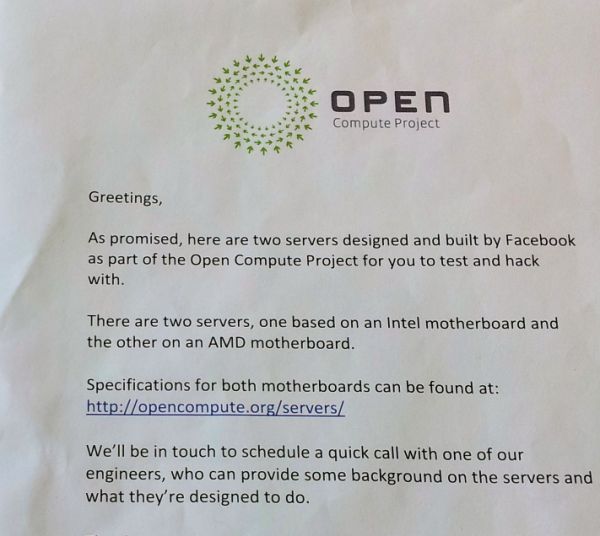Facebook's "Open Compute" Server tested
by Johan De Gelas on November 3, 2011 12:00 AM ESTFacebook Technology Overview
Facebook had 22 Million active users in the middle of 2007; fast forward to 2011 and the site now has 800 Million active users, with 400 million of them logging in every day. Facebook has grown exponentially, to say the least! To cope with this kind of exceptional growth and at the same time offer a reliable and cost effective service requires out of the box thinking. Typical high-end, brute force, ultra redundant software and hardware platforms (for example Oracle RAC databases running on top of a few IBM Power 795 systems) won’t do as they're too complicated, power hungry, and most importantly far too expensive for such extreme scaling.
Facebook first focused on thoroughly optimizing their software architecture, which we will cover briefly. The next step was the engineers at Facebook deciding to build their own servers to minimize the power and cost of their server infrastructure. Facebook Engineering then open sourced these designs to the community; you can download the specifications and mechanical CAD designs at the Open Compute site.
The Facebook Open Compute server design is ambitious: “The result is a data center full of vanity free servers which is 38% more efficient and 24% less expensive to build and run than other state-of-the-art data centers.” Even better is that Facebook Engineering sent two of these Open Compute servers to our lab for testing, allowing us to see how these servers compare to other solutions in the market.
As a competing solution we have an HP DL380 G7 in the lab. Recall from our last server clash that the HP DL380 G7 was one of the most power efficient servers of 2010. Is a server "targeted at the cloud" and designed by Facebook engineering able to beat one of the best and most popular general purpose servers? That is the question we'll answer in this article.











67 Comments
View All Comments
jhh - Saturday, November 5, 2011 - link
I'm not sure how much of the benchmarks depend on network bandwidth, but Facebook certainly does a lot of it. Using SRIOV based NICs and supporting drivers allows the VM to access virtual NIC hardware directly, without having to go through the hypervisor. But, all NICs aren't built equal, many of them do not support SRIOV, and those that do, may not have drivers which support it in older kernels such as Centos 5.6. Unfortunately, since most Gigabit NICs were designed before SRIOV, most gigabit NICs don't support it. We have great difficulty getting hardware vendors to describe whether the provide SRIOV capable hardware or Linux drivers. The newer 10G NICs tend to support SRIOV, but whether the server needs more than 1G is unclear, and the 10G NICs are more expensive and use more power.CPU-Hog - Sunday, November 6, 2011 - link
Good comparison of the servers however I couldn't help but think how much better it would be if we ran actual workloads that facebook etc plan to run in the datacenter vs. these enterprise workloads. How about running MemcacheD / Hadoop / HipHop etc. which are the key workloads the OpenCompute servers are designed to run well.Many of these workloads need large IO and memory vs. high compute. It will also be interesting to then use the same benchmarks to compare future servers based on technology from newbies like Calxeda, SeaMicro and AppliedMicro.
Xeon and Opterons based servers vs. ARM and Atom based servers. Now that battle of the old guard vs, the upstarts will be worth seeing.
trochevs - Wednesday, November 9, 2011 - link
Johan,Thank you for excellent article. I love to read about cutting edge technology. Keep with the good work. But, I notice something that nobody in the comments has mention yet. In the last paragraph:
"... being inspired by open source software (think ..., ..., iOS, ...)."
iOS is a Open Source Software?! When this happen?
mrgadgetgeek - Thursday, November 10, 2011 - link
Since these systems are custom designed by Facebook engineers, I'm guessing you can't purchase anything like it, correct? Will that change with that foundation that Open Compute announced recently?artemisgoldfish - Thursday, November 10, 2011 - link
Getting Power One to design a supply just right requires a LOT of testing. It's also strange to me that the supply only takes 200-277VAC. The Power One AC supplies I'm familiar with do 90VAC to 264VAC and pass 80PLUS Gold, maybe the tighter input range helps them tune it for more efficiency.ahmetmy330 - Friday, December 30, 2016 - link
you are free of charge to sort any sum of money in you intend to put in your Jurassic World job application. When using the formulated 100 % free Income and Nourishment it will be possible to fundamentally discover and acquiring everything around Jurassic World free of chargehttp://www.h2kjamaica.com/jurassicworldhack/
Chapon788 - Saturday, January 28, 2017 - link
Great Information sharing .. I am very happy to read this article .. thanks for giving us go through info.http://ultimatemobilehits.com/king-of-avalon-hack/